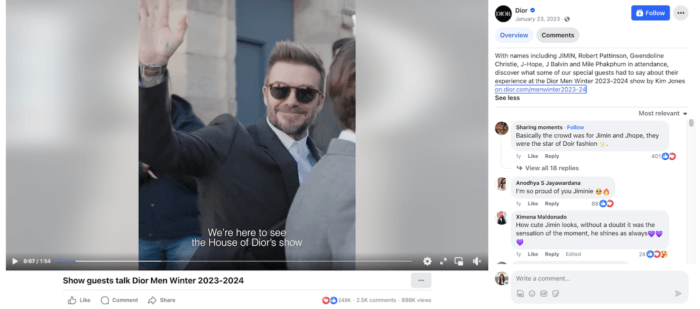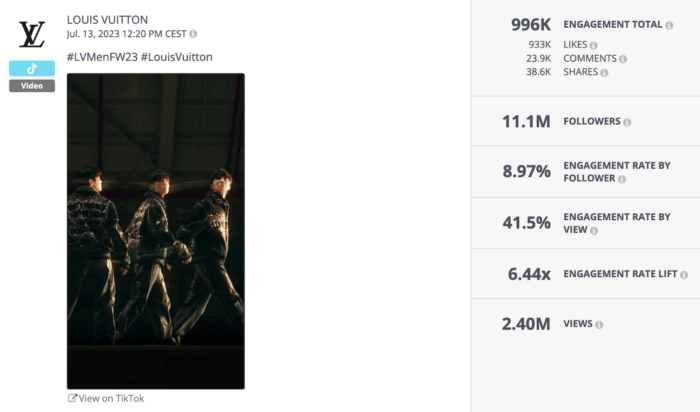From strategic celebrity partnerships to red-carpet events and a unique approach to TikTok, here are the top trends from the top luxury brands on social media.
The luxury market’s customer base is expected to hit 500M by 2030, according to a report on the luxury goods market. On their journey to reach these new limits or, perhaps, surpass them, we’ll continue to see luxury brands utilizing the power of social networks to shape their brand image and connect with their target audiences, which, as we’ll see later on, are shifting.
According to our latest Social Media Industry Benchmark Report, retail was among the lowest-performing industries on nearly every social media platform. They earned last-place engagement rates on Instagram and second-to-last on Facebook. This year, luxury and retail brands managed roughly comparable engagement rates, except on TikTok, where they pulled ahead.
Ready to analyze your brand's performance on social media. 
To see what strategies have helped these fashion houses win on social media, we analyzed over 20K of their posts across Facebook, Instagram, TikTok, and Twitter to bring you this report on the top trends from the top luxury brands.
Have any guesses about what they’ll be? Let’s dive in.
Top luxury brands on social media
When ranking the top luxury brands on social media, there are a few factors we consider, mainly the size of their audience, average total engagement per post, and average engagement rate by follower across the four main social media channels. With that in mind, here are the top luxury brands on social media.
In first place, we have Louis Vuitton, who generated the highest average cross-channel engagements per post at 66.7K. They also have the largest cross-channel following of any brand in this landscape at 102M—props to them for growing their following by 11.8% from the previous year.
Taking silver, we have Dior with an average of 56.8K cross-channel engagements and an audience of 81.3M. They also generated the most shares and conversation engagements across all social media platforms. Well done.
Rounding out the top three is Versace, who consistently had one of the highest engagement rates by follower on each social channel. They averaged 43.4K engagements per post, a 16.7% increase from last year, and built their following up to 43.2M.

Top trends from high-engagement luxury brands on social media
Featured trend #1: Celebrity brand ambassadors
Kicking off the top trends from luxury fashion brands, we have celebrity brand ambassadors. Putting a familiar face to their products helped brands build trust with consumers and shape their awareness on social media. From announcing a new collaboration to showcasing how these partners exemplify brand values, the luxury industry saw engagement skyrocket when posting about their ambassadors.
Take a look at the most successful cross-channel posts by total engagement.

Studies show that the Asia-Pacific region is the top market for luxury brands. So, it makes sense to see brands partnering with K-pop stars like J-Hope and Jisoo, who are pretty popular in the area (that’s putting it lightly). They’re also the perfect ambassadors to reach younger audiences worldwide, a good move considering younger Millennials, Gen-Z, and Gen Alpha are expected to make up 80% of luxury product consumers by 2030.
When Louis Vuitton announced on their Instagram account that BTS member J-Hope would be joining the team, they saw a 10.7% engagement rate by follower, a significant increase from the retail industry’s 0.23% average. The single-photo post, the content type that brought in the most engagement on Instagram, also included the hashtag #BTS, the most broadly used tag across channels with the highest engagement rate at 6.89%. It’s safe to say LV fans were pleased with this collab.

Let’s shift gears to Twitter. Here, Tiffany & Co had the highest engagement rate by follower at 0.33%, nearly 17x higher than the retail industry’s median engagement rate of 0.025%. Their most successful content had a few things in common: brand ambassador Jimin of BTS and photo or video content. Video content helped brands in this landscape bring in the most engagement on Twitter, followed closely by photos. Time and time again, we’ve seen the benefits of using visual elements to capture Twitter followers’ attention. This is especially true when a public figure is involved.
Tiffany & Co. also included links in their tweets to make it easier for followers to learn more about their products and used simple, brand-centered hashtags like #ThisIsTiffany while increasing exposure with #Jimin.

While exclusivity is the name of the game in the world of luxury brands, appealing to new demographics of consumers through strategic partnerships has proved to be a worthwhile effort. Brands in this landscape succeeded in doing so with ambassadors who embody complementary values like elegance, poise, and timelessness and have a solid rapport among younger followers.
Find out what is a good engagement rate on Instagram. 
Featured trend #2: Special events and collections
In a similar vein, followers also seem to love seeing A-list celebs dressed to the nines for special occasions. From runway shows to awards season, hashtags related to red-carpet events were the most popular in this landscape, namely music-related events like the Grammys and Beyonce’s Renaissance World Tour. These tags, along with #MetGala2023 and #GoldenGlobes, came with a particularly nice engagement rate lift across channels. Brands also found success showing off their latest and greatest collections at these events with the help of their ambassadors and guests.
Looking at the most popular topics and hashtags, we see an important element of luxury branding: exclusive experiences. For fans, it’s not just about the clothing item or accessory but the novelty that comes with it. Seeing big names at big events in fashion’s latest brings their products to life and gives brands that desired otherness that is so attractive to consumers.

Of all the social platforms, luxury brands struggled the most on Facebook, where their average engagement rate was 0.030%. However, capitalizing on the extra eyes that tune into big events helped them win additional support. A great example of this comes from Dior in what ended up being one of the top Facebook posts in the landscape. The nearly 2-minute-long clip from their 2023-2024 Men’s Winter Show features celebs arriving and walking the red carpet, interacting with interviewers, and snippets from the runaway show itself. This was a great way to give people at home a taste of the ambiance and hear what attendees thought of the impressive event (did someone say FOMO?). Name-dropping a few celebs in the post caption was also a good move to attract more viewers.

Although Versace recently deleted almost all of their social media presence to kick off a new era with creative director Anthony Vaccarello, we still want to draw attention to their content from the 2023 Met Gala. Last year’s Met was particularly special for luxury fashion brands as they paid tribute to renowned designer Karl Lagerfeld. In one of the top posts about the event, Versace went into great detail describing the thought, effort, and history behind ambassador Anne Hathaway’s ensemble and how it related to the theme. Doing so created a lot of social buzz on the post to the tune of 1.84K comments.
There’s definitely something to be said for letting a product speak for itself, but in this case, delving into the significance of the design helped Versace create an experience for onlookers that showed it was much more than a pretty gown.

Luxury brands have a lot in common in terms of target audiences and how they market themselves, but they are also all unique entities. Showing off different facets of their brands at big events and through their collections is one way they were able to really captivate audiences this past year on their social media accounts.
Featured trend #3: Making TikTok their own
Only half of the brands in this landscape actively post to TikTok, which is interesting considering it’s the platform where brands across industries have largely generated the highest engagement rates. There could be a couple of reasons for this. Luxury fashion brands might see the more laid-back and accessible nature of TikTok as inconsistent with their more polished and exclusive image. Or maybe they’ve determined their target audience’s presence on the app, or lack thereof, doesn’t warrant the effort. However, not only are younger generations predicted to make up the large majority of luxury markets by the end of the decade, but Gen Zers, the largest age demographic of TikTok users, are buying luxury items three to five years earlier than millennials around age 15. Given this shift in the luxury market, it will be interesting to see if more luxury brands jump on the TikTok train in 2024 to appeal to younger audiences or keep their positions.
Luxury brands in this landscape who do post on TikTok did so on average around 21 times per week, generating an average engagement rate by view of 3.61%, the highest of any other social channel. Versace had the highest engagement rate at 7.98% and leaned heavily into a few familiar trends: brand ambassadors, new collections, and fashion shows. Their top post pulled off a 29.9% engagement rate and teased a clip of ambassador Hyunjin of Stray Kids for their holiday collection.

You’ll notice a consistent video style when scrolling through Versace’s feed. Their clips are exceptionally high quality, with sharp images, dynamic angles, and professional-level editing. Like most brands in this landscape, the fashion house stays away from popular TikTok trends and trending audios, favoring their commercial or campaign-style content and original sounds. This ties into the idea that luxury brands want to set themselves apart from the mainstream rather than follow trends.
We should also shout out to Louis Vuitton, whose TikToks occupied several of the top spots in the landscape, averaging an engagement rate of 3.39%. Their most successful post, with a 41.5% engagement rate by view, featured ambassador J-Hope in a futuristic, cinematic-style advertisement for the 2023 Men’s Fashion Week collection. The post received nearly 24K comments and was shared over 38.6K times. Now’s a good time to note that in the world of social media marketing, we like to give special importance to comments and shares since they’re the engagement actions that require the most effort from followers.

There doesn’t seem to be an overwhelming consensus on whether TikTok is “in” for luxury fashion brands. However, several brands have demonstrated that the most effective way to navigate the platform is simply by showing up authentically. Luxury fashion brands can maintain their refined and exclusive style on TikTok by creating unique content and utilizing high-quality footage.
Methodology
With the help of Rival IQ, a Quid company, we analyzed 20K Instagram, Facebook, TikTok, and Twitter posts between December 31, 2022, and December 30, 2023. The 12 luxury brands surveyed have followers ranging between 17.5M to over 102M and include all brands featured in this article, as well as Chanel, Burberry, Dolce & Gabbana, Gucci, Hermes, Prada, Rolex, and Swarovski.
To determine the top luxury brands on social media, we focused on key metrics such as engagement rates, follower count, follower growth, and more.
Note: When we talk about engagement rates, we refer to a post’s measurable interactions, including likes, retweets, comments, shares, etc., divided by the total number of followers. Here’s the formula:
Engagement rate = [total engagement] / [total number of followers]
Wrapping up the top luxury brands on social media
What did you think of trends from the top luxury brands on social media? Were there any that surprised you? What would you have added?
Luxury brands have done a great job claiming their corner in the market online. We’ve seen the best brands harness the influence of brand ambassadors to earn followers’ trust and appeal to younger audiences, show off impressive collections at red-carpet events, and make TikTok work for them.
